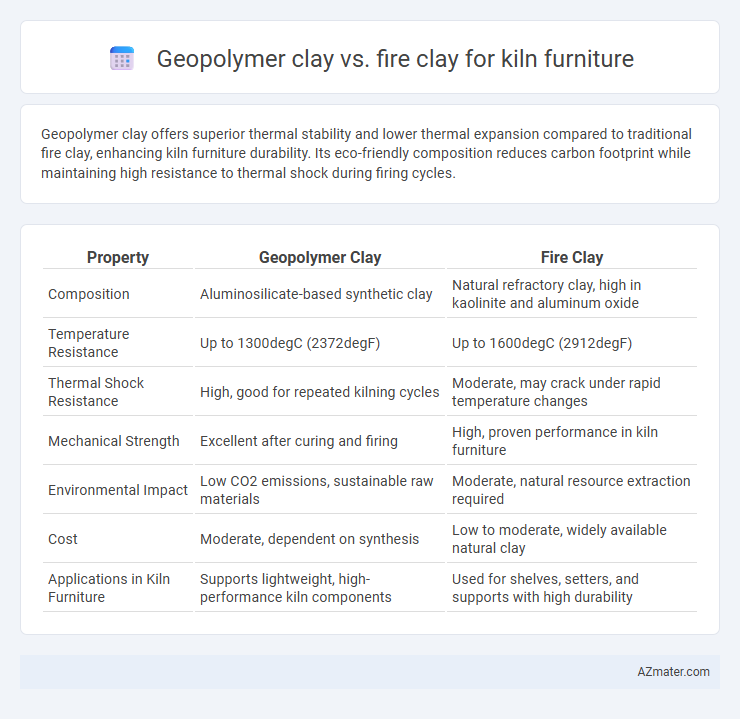Geopolymer clay offers superior thermal stability and lower thermal expansion compared to traditional fire clay, enhancing kiln furniture durability. Its eco-friendly composition reduces carbon footprint while maintaining high resistance to thermal shock during firing cycles.
Table of Comparison
| Property | Geopolymer Clay | Fire Clay |
|---|---|---|
| Composition | Aluminosilicate-based synthetic clay | Natural refractory clay, high in kaolinite and aluminum oxide |
| Temperature Resistance | Up to 1300degC (2372degF) | Up to 1600degC (2912degF) |
| Thermal Shock Resistance | High, good for repeated kilning cycles | Moderate, may crack under rapid temperature changes |
| Mechanical Strength | Excellent after curing and firing | High, proven performance in kiln furniture |
| Environmental Impact | Low CO2 emissions, sustainable raw materials | Moderate, natural resource extraction required |
| Cost | Moderate, dependent on synthesis | Low to moderate, widely available natural clay |
| Applications in Kiln Furniture | Supports lightweight, high-performance kiln components | Used for shelves, setters, and supports with high durability |
Introduction to Kiln Furniture Materials
Kiln furniture materials must withstand extreme temperatures and thermal shock while maintaining structural integrity. Geopolymer clay offers superior thermal resistance and environmental benefits due to its aluminosilicate-based composition, which forms a strong ceramic matrix upon curing. Fire clay, traditionally used for kiln furniture, provides excellent heat resistance and durability derived from natural clay minerals but can be less eco-friendly and heavier compared to geopolymer alternatives.
What is Geopolymer Clay?
Geopolymer clay is an inorganic material composed of aluminosilicate minerals activated by alkaline solutions, forming a durable, heat-resistant compound ideal for kiln furniture. Unlike fire clay, which is naturally occurring and primarily composed of kaolinite and other refractory clays, geopolymer clay offers enhanced thermal stability and reduced shrinkage at high temperatures. Its chemical structure enables superior resistance to thermal shock, making it a modern alternative in high-temperature applications.
Understanding Fire Clay Properties
Fire clay is prized for its high alumina content and excellent thermal stability, enabling it to withstand temperatures above 1,500degC without deforming or melting. Its refractory properties include low thermal conductivity and strong resistance to thermal shock, making it ideal for kiln furniture that must endure rapid temperature changes. Compared to geopolymer clay, fire clay offers superior durability and structural integrity under prolonged exposure to intense kiln environments.
Thermal Stability: Geopolymer Clay vs Fire Clay
Geopolymer clay offers superior thermal stability compared to traditional fire clay due to its inorganic polymer matrix, which resists thermal shock and maintains structural integrity at temperatures exceeding 1200degC. Fire clay, though capable of withstanding high temperatures up to 1500degC, tends to experience gradual sintering and shrinkage, potentially compromising kiln furniture durability over extended use. The enhanced thermal stability of geopolymer clay reduces deformation and extends the service life of kiln furniture in high-temperature ceramic firing applications.
Mechanical Strength Comparison
Geopolymer clay exhibits superior mechanical strength compared to traditional fire clay when used in kiln furniture, offering enhanced load-bearing capacity and resistance to thermal shock. Its inorganic polymer matrix provides improved structural integrity at high temperatures, reducing deformation and extending service life. Fire clay, while durable, generally has lower compressive strength and is more prone to wear under cyclic thermal stress.
Resistance to Chemical Attack
Geopolymer clay exhibits superior resistance to chemical attack compared to fire clay, maintaining structural integrity in highly acidic or alkaline environments commonly encountered in kiln operations. The aluminosilicate matrix of geopolymer clay provides enhanced durability against corrosive slags and fluxes, minimizing degradation over extended firing cycles. Fire clay, while traditionally used for kiln furniture, tends to be more susceptible to chemical erosion, leading to reduced lifespan and more frequent replacements.
Sustainability and Environmental Impact
Geopolymer clay offers a sustainable alternative to traditional fire clay for kiln furniture by utilizing industrial byproducts such as fly ash and slag, significantly reducing raw material extraction and landfill waste. Fire clay, while durable and heat-resistant, often involves environmentally intensive mining processes that contribute to habitat disruption and carbon emissions. The low carbon footprint and potential for recycling geopolymer clay make it a more eco-friendly choice for high-temperature applications in ceramic and metallurgical industries.
Cost and Availability
Geopolymer clay offers a cost-effective alternative to traditional fire clay for kiln furniture, with raw materials often derived from industrial by-products, reducing expenses. Fire clay, though widely available commercially, may involve higher extraction and processing costs, impacting overall price and supply consistency. Geopolymer clay's growing availability in industrial markets positions it as a competitive choice for kiln furniture manufacturing.
Performance in High-Temperature Kiln Applications
Geopolymer clay offers superior thermal stability and resistance to thermal shock compared to traditional fire clay, making it highly effective for kiln furniture in temperatures exceeding 1300degC. Its low thermal conductivity reduces heat loss, enhancing energy efficiency during firing cycles. Fire clay remains durable but may exhibit greater deformation and wear at ultrahigh temperatures due to its reliance on natural mineral composition, limiting its long-term performance in demanding kiln environments.
Conclusion: Choosing the Right Clay for Kiln Furniture
Geopolymer clay offers superior thermal shock resistance and environmental benefits compared to traditional fire clay, making it ideal for kiln furniture exposed to rapid temperature changes. Fire clay remains a cost-effective option with proven durability and availability, suitable for standard firing applications. Selecting the right clay depends on specific kiln operating conditions, budget considerations, and desired performance characteristics.

Infographic: Geopolymer clay vs Fire clay for Kiln furniture
 azmater.com
azmater.com